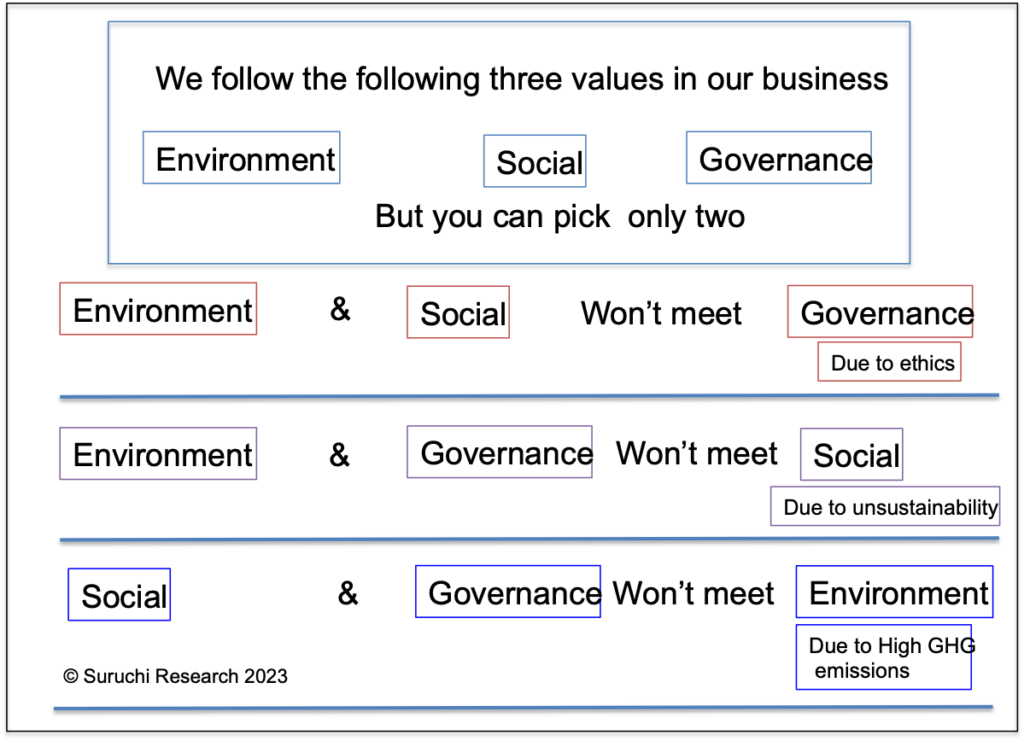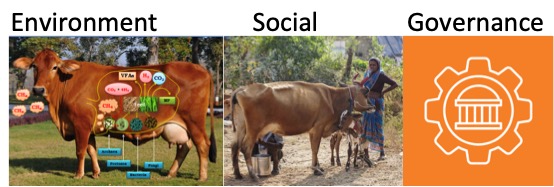“I serve Environment, Sustainability and Governance in the dairy sector . Choose any two” .
I remember visiting a Highway motel in the UK in 2006 while conducting a survey on milk products. The menu placard on my table read “We serve Quality, Service and Price “. Choose any two. It was like a puzzle for me. Then I started to decode the message. It clearly indicated that if you want good quality food with fast service then don’t ask for a low price. In case of fast service at a low price, forget the quality . Lastly, high quality food at a high price will not come quickly on your table.
I found something similar in today’s time while everyone is talking about ESG. Everyone is looking at the dairy sector with scepticism and using the ESG lens to evaluate the investment option in the dairy sector. First let us understand what this ESG is all about.
What is ESG ?
ESG stands for Environmental, Social, and Governance. It is a framework that is used to assess the sustainability and ethical impact of investments in companies.
The “E” in ESG refers to environmental factors, which include a company’s impact on the natural environment. This can include issues such as climate change, carbon emissions, water usage, waste management, and biodiversity.
The “S” in ESG represents social factors, which consider a company’s relationships with stakeholders and its impact on society. Social factors may include labor practices, employee welfare, community engagement, human rights, diversity and inclusion, product safety, and customer satisfaction.
The “G” in ESG stands for governance, which focuses on the internal practices and structures of a company. It involves assessing the company’s leadership, executive compensation, board diversity and independence, shareholder rights, and transparency in financial reporting.
What does ESG stand for in the dairy sector ?
Environment – GHG Emission and water footprint
Social- Inclusion or Sustainability for producers and Health and Nutrition for the consumers
Governance – Emission benchmarks and ethics
I tried to solve this puzzle of achieving the highest standards of ESG compliance in dairy sector but ended up with the same doctrine which I learnt, 17 years back in the United Kingdom i.e Choose any two .
Choose any two Model out of ESG in dairy sector

There are numerous reports and research papers talking negatively about the dairy sector. Lancet reports on Food and recent research by Nature are advocating to change the food choices in order to save the planet. It means if we have to meet the carbon neutral targets ( Governance) for dairy then we need to switch to plant based alternatives. In an Indian context that would mean directly snatching livelihood opportunities from 100 millions households. It will also lead to an immediate crisis of alternative healthy and nutritious foods for the millions of children under five years of age initially. So if we follow governance strictly in a sector on environmental issues then we will have to forgo sustainability or the social part of the ESG.
Governance is about ethics also
Let us try to find the right fit of protecting the environment without impacting sustainability of the rural households. In that case we may have to improve the breeds and increase productivity. But simultaneously we will have to cull and slaughter millions of unproductive, old, unproductive cattle. Cow is considered a sacred animal in India. Our business ethics direct us to protect these sacred animals. So in one way or the other we will have to forgo governance while protecting Environment and Social elements.
Finally If we follow our ethics by protecting the cattle . And maintain a status quo on cow rearing for sustainability of small and marginal farmers .And ensuring ample supplies of healthy and nutritious milk and milk products in the country. Then we are surely going to increase the contribution of dairy linked emission in agriculture. Currently dairy contributes almost 70% to the total agriculture emission and agriculture contributes nearly 30 % to the total emission. This way we are going to impact environment for sure.
The way forward
Under current circumstances the only way forward is to divert all funds towards carbon neutrality. Let there be ample funds available from the developed world to the developing countries for getting carbon credits. Developing countries must be asked to develop a longterm carbon neutrality regime using both carbon insetting and offsetting.
Putting an end to consumption of over 8000 years old and proven food i.e milk is not the solution. Rather we need to protect cows and milk in the same spirit in which we protect the human race against all odds.
I am looking forward to the day when E+S+G will coexist in the dairy sector in India. I also seek a different outlook from the investors community towards the dairy sector. They just can’t turn their back towards this flourishing industry handling first food for life . It also gives livelihood to 100 millions small and marginal farmers in India who are rearing 300 million bovine livestock.
Source : Dairy blog by Kuldeep Sharma Chief editor Dairynews7x7 channel

